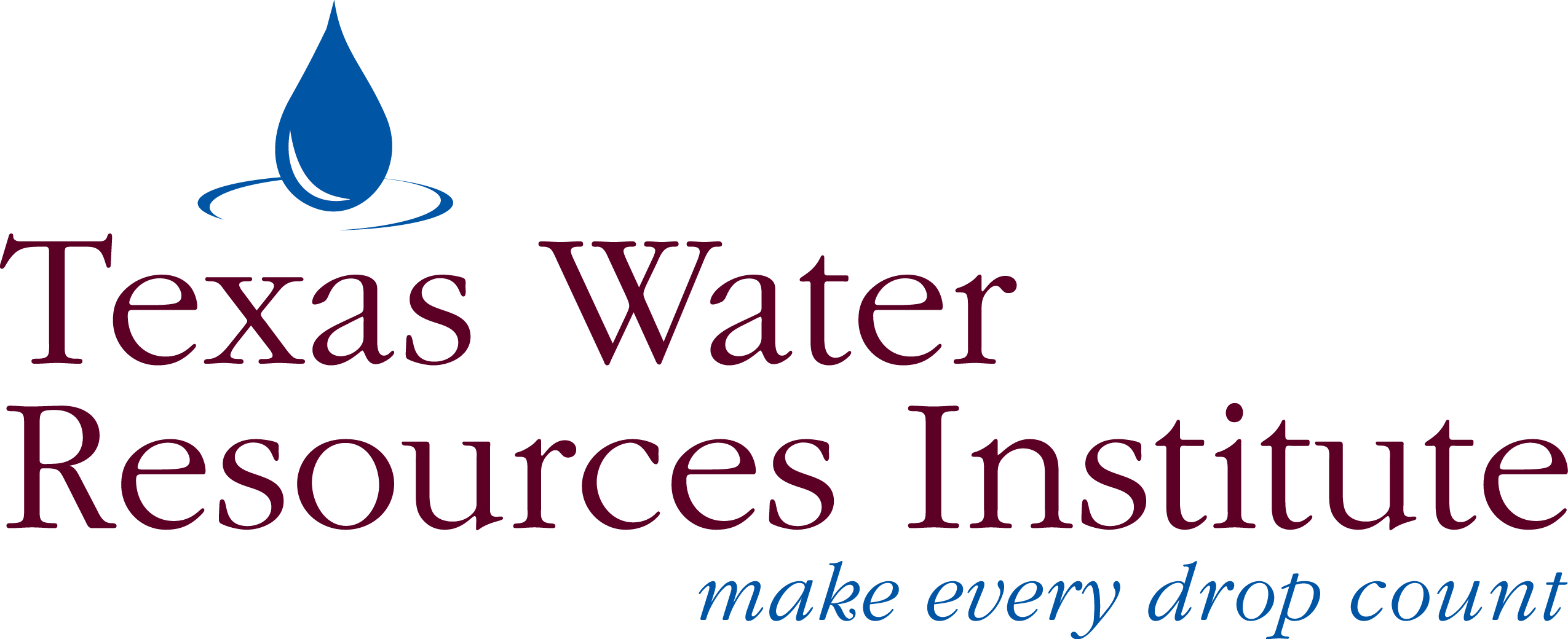Estimated reading time: 12 minutes
These 10 state-funded research projects are advancing Texas water
More Information
Want to get txH20 delivered right to your inbox? Click to subscribe.
The water problems facing Texas are as diverse as the state’s vast landscape, and many involve information gaps and research questions difficult for singular academic departments or research labs to solve.
That’s where multidisciplinary teams come in.
In early 2023, Texas A&M AgriLife Research and the Texas Water Resources Institute (TWRI) released a call for research proposals from dynamic teams tackling future-minded Texas water problems. Each project team was required to include at least one representative from each of these Texas A&M University System agencies: Texas A&M AgriLife Research, the Texas A&M AgriLife Extension Service, and the Texas A&M Engineering Experiment Station (TEES).
Researchers across Texas submitted proposals, and in September 2023 ten water research projects from throughout the Texas A&M System received a total of $2.39 million in funding through appropriations from the Texas Legislature to Texas A&M AgriLife Research, administered by TWRI. Each submission went through a panel review with representatives from all three agencies. The funded projects began on Sept. 1, 2023, and conclude on Aug. 31, 2025.
Seed grant strategy produces results
“The purpose of this initiative is investing in multidisciplinary teams to be leaders in emerging fields,” said Allen Berthold, Ph.D., TWRI associate director. “These funds grow these teams’ capacity and help them secure additional external resources to continue advancing water management and technology in Texas.”
Bringing multidisciplinary teams together to develop pilot projects and then building on those to submit larger proposals to external funding agencies has proven to be an effective strategy for tackling major water issues, he said.
Continue reading to learn more about the research projects, scientists leading them and progress made so far.

Enhancing corn water-use efficiency through integration of sensor, crop model and machine learning-based approaches
Principal investigator (PI): Srinivasulu Ale, Ph.D., AgriLife Research, Vernon.
Co-PIs: Qingwu Xue, Ph.D., AgriLife Research; Thomas Marek, Ph.D., AgriLife Research; Chukwuzubelu Ufodike, Ph.D., TEES; Jourdan Bell, Ph.D., AgriLife Extension.
In Texas’ Northern High Plains, corn is a key crop, and enhancing corn water-use efficiency is increasingly important, Ale said. The region faces declining Ogallala Aquifer groundwater levels, recurring droughts, and anticipated warmer and drier weather conditions. This research team is pursuing an integrated approach, combining sensor technology, a crop model, and machine learning to optimize irrigation management and increase corn yield while conserving water resources.
By developing a deep learning machine model that utilizes crop sensor data, unmanned aerial vehicle data, and Decision Support System for Agrotechnology Transfer cropping system model outputs, the team aims to increase regional water-use efficiency and crop productivity. They use wired and wireless sensors that monitor sap flow, plant health, canopy temperature and soil moisture.
The corn field experiment at Bushland is collecting planned sensor output and performance data, plant growth performance measurements, and irrigation event monitoring. The data from ongoing and past corn field experiments will be used to develop crop-growth-stage-based efficient irrigation strategies for the study region.

Advanced irrigation management system guided by remote sensing and artificial intelligence
PI: Craig Bednarz, Ph.D., AgriLife Research, Amarillo.
Co-PIs: Nick Duffield, Ph.D., TEES; Mahendra Bhandari, Ph.D., AgriLife Research; David Parker, Ph.D., AgriLife Extension.
Scheduling and managing irrigation decisions in Texas can be incredibly complicated. Bednarz and team are developing an unmanned aerial system (UAS)-based crop monitoring system that calculates crop water use for irrigation scheduling and increased water-use efficiency. They’re using big data analytics and artificial intelligence on the UAS-derived phenotypic data and infield weather data to calculate actual crop evapotranspiration, biomass accumulation, and determine the timing and quantity of irrigation water needed.
They hypothesize that quantifying crop canopy cover accurately and in a timely manner should significantly improve irrigation efficiency.
The researchers are working to establish an empirical relationship between remote sensing-derived canopy features and crop coefficient, and then identify the remote sensing-based canopy vegetation index that provides the best efficiency. They’ll then develop and validate an irrigation scheduling approach that uses those crop coefficients and canopy efficiency estimates. To make their results publicly accessible, they plan to develop a web-based digital portal called “AIMS” integrating imagery and models for use as an irrigation scheduling system.
Conducting field studies in Corpus Christi, Lubbock and Bushland, they are measuring crop water use, biomass accumulation, and a suite of drone-derived crop data. In 2024 the team was collecting UAS, yield, irrigation and soil moisture data from the Bushland and Lubbock locations.

A risk-based approach to mobilize South Texas communities for groundwater management and water quality
PI: Susie Dai, Ph.D., formerly AgriLife Research, College Station.
Co-PIs: Garrett McKay, Ph.D., TEES; Joel Pigg, AgriLife Extension; Omar Montemayor, AgriLife Extension.
*Note: This project’s proposal was for a smaller support grant, for 1 year of funds.
Groundwater arsenic contamination in the Southern Gulf Coast Aquifer presents a critical public health concern. Estimates show that about 4 million Texans rely on the public water supply that contains more than 5 parts per billion (ppb) arsenic, Dai said, and approximately 180,000 people drink water containing more than 10 ppb arsenic, the maximum containment level in Texas.
This team is conducting arsenic groundwater contamination testing, modeling, human biomonitoring, education and outreach in the Texas-Mexico border region. Combining risk-based arsenic sampling, testing and citizen science strategies, they are mobilizing communities, promoting drinking water quality awareness and providing filters.
Texas A&M AgriLife Extension Service agents and specialists have established local networks in these communities. At events for AgriLife Extension’s Texas Well Owner Network program and Healthy South Texas program, Dai’s team recruits participants and then sends them water sample kits. If the kit analysis results show high arsenic levels, the team helps residents access personal arsenic exposure testing.
The project screened 429 residential water samples in 2022-2023. Arsenic does not present uniformly across the region but instead in specific hotspots, and in 2023, they identified high-risk regions in Starr County. In 2024, the team tested commercially available filters to identify those most effective at removing arsenic and then began distributing filter pitchers to households needing them. The team also conducted a community-based survey measuring water quality perceptions, water treatment and testing options.
“We want to give these residents solutions, not just leave them hanging,” Dai said. “Forming local coalitions with AgriLife Extension on the ground is proving very effective.”

Climate-smart alternate wetting and drying rice production
Principal investigator (PI): Fugen Dou, Ph.D., AgriLife Research, Beaumont.
Co-principal investigators (Co-PIs): Xingmao Ma, Ph.D., TEES; Jake Mowrer, Ph.D., AgriLife Extension; Terry Gentry, Ph.D., AgriLife Research.
Rice is critically important to the global food supply chain and is the staple crop for most people on Earth. Texas A&M System scientists are working to find more sustainable rice production techniques.
Alternate wetting and drying, or AWD, is one of the emerging water management practices for rice production, but AWD has not yet been extensively researched in Texas. Based in Beaumont, Dou and his research team are developing a climate-smart AWD rice production system by experimenting with various degrees of AWD application, on different soils, in multiple growing seasons. They are also measuring the effect of AWD on arsenic and cadmium uptake in rice production. “For paddy rice, flooded soil conditions favor arsenic update more than in upland crop conditions,” Dou said. “Not all arsenic has a health concern; currently only inorganic arsenic does.”
In the fall of 2024, the AWD rice trials continued to show promise, and the research team shared the preliminary results with rice producers during the annual rice field days at the Eagle Lake Station and Texas A&M AgriLife Beaumont Center. They measure rice yields from AWD fields and control fields, extract soil samples for RNA sequencing and soil health analysis and collect weekly greenhouse gas samples.

Projection of hydrologic intensity duration frequency parameters and their uncertainties based on climate projections for 21st century in the state of Texas
PI: Bardia Heidari, Ph.D., AgriLife Research, Dallas.
Co-PIs: Fouad H. Jaber, Ph.D., AgriLife Research; Nicholas G. Duffield, Ph.D., TEES.
The frequency and intensity of extreme precipitation have been changing globally, including in the United States and in Texas. Heidari and his team are developing an array of traditional statistical methods and machine learning models to update the intensity-duration-frequency (IDF) curves for modeling predicted precipitation in Texas for the next 80 years. They are working to downscale, bias-correct, disaggregate the projected precipitation values, and quantify uncertainties, for the next 80 years.
The significant ecoregion variability across Texas also makes precipitation modeling extremely difficult.
The results from this study will improve flood planning and disaster response for the state. They also plan for the method to be scalable and transferable to other locations, enabling the scientific community and engineers to better adapt to future rainfall patterns.
Without bias-correction, the intensity of extreme precipitation value would be heavily underestimated, Heidari said, and the team made major progress processing such data in fall 2024. So far, as the team has tested and compared models, they have found that the Prophet model, an open-source software that is a procedure for forecasting time series data based on an additive model where non-linear trends are fit with yearly, weekly and daily seasonality, has outperformed the other tested time-series methods, Heidari said.

Satellite remote sensing for agricultural water system management in Texas
PI: Zong Liu, Ph.D., AgriLife Research, College Station.
Co-PIs: Huilin Gao, Ph.D., TEES; Jennifer Spencer, Ph.D., AgriLife Extension.
Texas is currently the 4th-most-dairy-producing state in the country. Dairy producers contribute both economically and environmentally, managing major amounts of manure and working to protect local water quality.
Because manure management does contribute to greenhouse gas emissions and can be a source of water quality impairment, Liu said, researchers are using emerging technology to improve management tools. His team is testing satellite remote sensing for animal wastewater monitoring and automatic pond mapping using satellite imagery.
Analyzing lagoons’ color-change data from satellite imagery can help predict water quality issues. Satellite remote sensing data is already used by many scientists tackling diverse water issues, including co-PI Gao, currently leading three NASA-funded research projects monitoring reservoirs at regional and global scales.
The team is working to develop a satellite-observing framework to identify, characterize, and monitor farm lagoons in Texas; understand the relationship between satellite remote sensing data to lagoon water quality and greenhouse gas emissions; and develop a national initiative for holistic assessment of agricultural wastewater management.
They are also producing educational videos on the Texas Manure YouTube channel and providing in-person training events for producers.

On-site wastewater monitoring using miniaturized optical-sensing chips
PI: Pao Tai Lin, Ph.D., TEES, College Station.
Co-PIs: Anish Jantrania, Ph.D., AgriLife Extension; June Wolfe, Ph.D., AgriLife Research.
More than 6.2 million Texans rely on on-site sewage facilities (OSSF), or septic systems, of which more than 10% use aerobic treatment systems. To maintain these systems, disinfection is needed, most commonly using chlorine, and most owners rely on service providers for maintenance, typically 2-4 times per year. Malfunctioning chlorine disinfection systems may go months without detection and repair, potentially harming residents and neighbors.
Lin and his collaborators see the potential for real-time detection of inadequate OSSF discharge disinfection being improved through low-cost, in-line, accurate and compact chlorine sensors. They are developing a chip-scale water sensor to enable real-time chemical detection. Using these chlorine-specific optical sensors could lower the cost of aerobic system operation and maintenance while also protecting environmental health. The miniaturized sensors will be fabricated by semiconductor processes that enable low-cost, high-volume production, and long-term operation, he said. So far, the team has made major progress in fabricating these sensors and evaluating their performance in chlorine detection.
This project is conducting testing at the Texas A&M Mid-Infrared Integrated Photonics and Remote Sensing (MiPRoS) Laboratory and Texas A&M OSSF Research Center at the RELLIS Campus.

Optimizing agricultural water management: A climate-smart approach to reduce carbon intensity and harness carbon market opportunities
PI: Nithya Rajan, Ph.D., AgriLife Research, College Station.
Co-PIs: Salvatore Calabrese, Ph.D., AgriLife Research; Francisco (Pancho) Abello, Ph.D., AgriLife Extension; Nick Duffield, Ph.D., TEES.
What if we could incentivize farmers through financial compensation for implementing water conservation practices by using emerging carbon markets? Rajan and collaborators are studying the relationship between optimal irrigation practices, carbon intensity, and financial benefits.
Today in Texas, there is a significant variation in the application efficiency of different irrigation methods, Rajan said. In Texas, sprinkler irrigation covers approximately 78% of the irrigated land, and application efficiency ranges from 60-95%.
This project aims to answer critical questions about the impact of different irrigation systems’ impacts on greenhouse gas emissions from large-scale crop production, such as cotton in Texas. For an irrigation practice to be climate-smart, overall greenhouse gas emissions need to decrease, Rajan said.
Rajan is currently leading several other multimillion-dollar climate-smart agriculture research initiatives, and this pilot project complements those efforts. “Generating data through this seed grant project will enable us to demonstrate that irrigation management could also be eligible for these climate-based markets, providing additional income to farmers,” she said. “However, currently, there is no existing data to support this claim. To position ourselves to advance water management in Texas, seed grants like this are necessary to test innovative ideas and generate preliminary data, establishing a successful track record of research at Texas A&M.”
"This work has the potential to transform irrigation practices, benefiting farmers across Texas," she said.

Next generation sustainable water treatment system using engineered nano materials
PI: Velumani Subramaniam, Ph.D., TEES, College Station.
Co-PIs: Guillermo Aguilar, Ph.D., TEES; Anish Jantrania, Ph.D., AgriLife Extension; June Wolfe, Ph.D., AgriLife Research.
Subramaniam and his team are pioneering the development of a lab-scale prototype and a pilot field-scale water treatment plant designed to address critical wastewater challenges. Their approach combines advanced photocatalysis and adsorption technologies to clean and reuse wastewater effectively.
“This innovative system is envisioned to be self-sustaining, capable of operating with minimal external inputs while meeting stringent water quality standards,” he said.
The targeted contaminants include heavy toxic metals, metalloids, non-metals, microorganisms, and persistent organic pollutants, such as per- and polyfluoroalkyl substances (PFAS). By leveraging nanotechnology, the project aims to deliver a cutting-edge, portable, and scalable solution to combat water pollution, Subramaniam said.
“The significance of such a system is particularly acute in Texas, where extreme weather conditions and aging infrastructure have heightened vulnerabilities in wastewater treatment,” he said. “These challenges underscore the urgent need for resilient and adaptive wastewater treatment solutions, particularly in regions facing similar environmental and infrastructural stressors.
This team is exploring a variety of nanomaterials with unique properties that enhance the efficiency of PFAS remediation. Preliminary results have shown promise, demonstrating the potential of these materials to not only degrade PFAS but also to remove other pollutants effectively.

Scalable anti-fouling MXene quantum dots membrane-based energy-efficient water desalination
PI: Shiren Wang, Ph.D., TEES, College Station.
Co-PIs: Jingjing Qiu, Ph.D., TEES; Murthy Girisha Ganjegunte Keshava, Ph.D., AgriLife Research; Anish Jantrania, Ph.D., AgriLife Extension.
Reverse osmosis (RO) is the most common method for desalination worldwide, but its energy consumption is very high, Wang said. His research team is developing a desalination process that uses nanostructures and consumes much less energy.
“It is crucial to make significant advancements in reducing operational pressure for achieving energy-efficient desalination while maintaining optimal performance,” Wang said.
This team is developing energy-efficient water desalination through a new class of anti-fouling membranes made from the crosslinked MXene quantum dots, or MQDs, which could minimize the water flow resistance for high flux while maintaining high rejection of salt, he said. So far, they have begun the computational design of MQD membranes, and this year they are manufacturing RO membranes using MQDs, characterizing the anti-fouling properties of the as-manufactured membrane, and evaluating the desalination performance, energy consumption, and cost analysis of the proposed water purification.
Explore this Issue
Authors
As communications manager, Leslie Lee leads TWRI's communications and marketing strategy and team, manages TWRI's publications, and coordinates effective communications support for TWRI's numerous projects serving the state of Texas.












